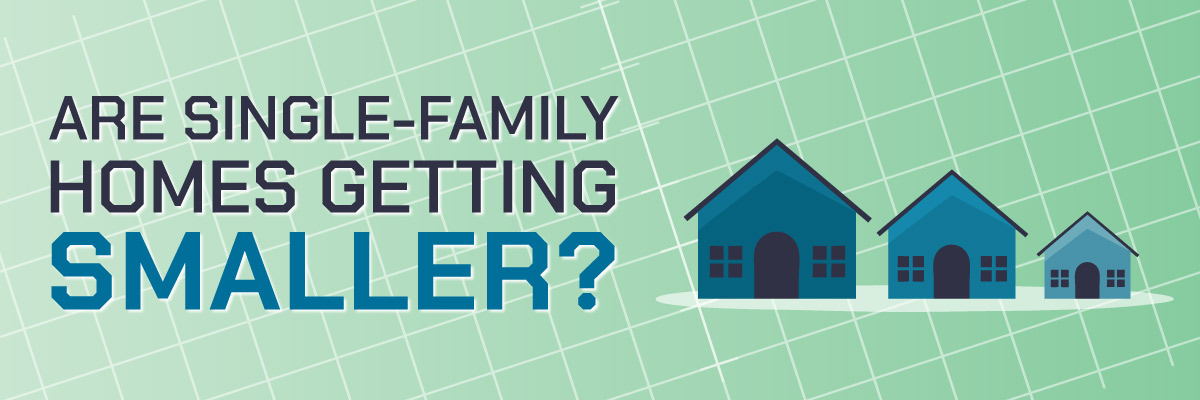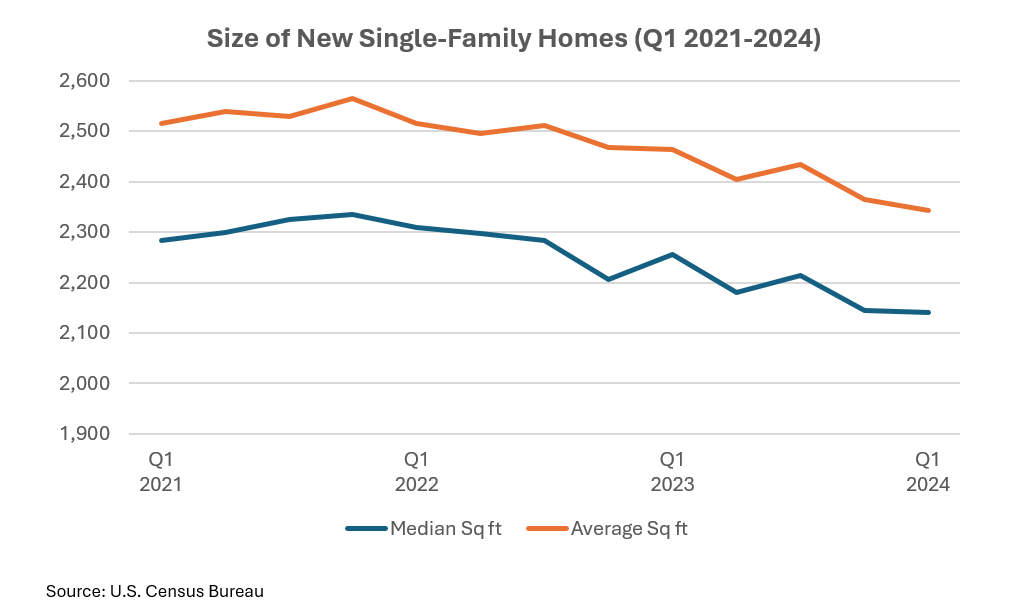Are Single-Family Homes Getting Smaller?
August 5, 2024

Buyer preferences have shifted over the last decade as low inventory and high rates continue to affect the market. One of those preferences is home size, as the “McMansions” that were popular in the last decade have taken a backseat to smaller more affordable homes in some markets. Let’s explore how home sizes have changed and its effect on buyers and homebuilders.
Home Sizes Falling Since 2015
The economic recovery after the Great Recession and limited supply of entry level homes led to a greater demand for larger homes. By 2015, new home sizes peaked at 2,467 sq. ft. The median home size would continue to go down until 2020 when the pandemic and work from home drove the need for more space. As buying demand increased so did the size of new single-family homes, which by the end of 2021 had a median sq. ft. at 2,335. This trend would reverse in 2022, as home prices and mortgage rates began to rise, and some would-be buyers were pushed to the sidelines. In the final quarter of 2023, the median floor size was 2,145 sq. ft., 13% lower than eight years ago.
Newer, Smaller Homes
Affordability challenges over the last few years have impacted home-buying decisions with many buyers opting for smaller homes. A survey by the National Association of Home Builders found that in 2023, buyers wanted a home that was 2,067 sq. ft., which is 193 sq. ft. less than 20 years ago. Over the last few years, new builds have become more of a viable option for buyers looking to move into homes with a lower square footage. In May of 2018, new homes were 500 ft. larger than existing homes, and this dropped to 335 square feet in 2024. Because many of the new builds are for smaller homes, in some cases they have also become more affordable with builders’ offering incentives to potential buyers, plus the cheaper price per square foot. Newer, single-family homes sold for $209.70 per sq. ft. in May of this year, $3.50 less than the price per sq. ft. of existing homes.

Homebuilders Shift to Building Smaller
Higher construction costs and a shortage of labor and lots, have changed the way builders are constructing newer homes. A survey by NAHB found that more than 38% of builders constructed homes with smaller floor plans in 2023 and 26% will continue to do this in 2024. The first quarter of this year has already seen a new single-family home size dip with the median floor area at 2,140 sq. ft., 116 sq. ft. smaller than last year. This is the lowest new home size since the second half of 2009. With homes becoming more compact, builders and designers are finding new ways to maximize space for buyers. The first is having fewer hallways and incorporating more flex spaces to optimize every square foot of available room. Builders are also turning their sights to townhomes to alleviate buyer and construction costs. In Q1 2024, construction began on 42,000 townhomes, a 45% increase from last year.
For more information on housing, demographic, and economic trends in Virginia, be sure to check out Virginia REALTORS® other Economic Insights blogs.
You might also like…
Key Takeaways: February 2025 Virginia Home Sales Report
By Virginia REALTORS® - March 25, 2025
Key Takeaways There was a pullback in closed sales in February. There were 6,129 homes sold statewide this month, down 9% from last February, a reduction of 604… Read More
March Madness Meets Market Madness: Construction Trends in Virginia’s College Towns
By Abel Opoku-Adjei - March 18, 2025
Ongoing economic concerns are impacting both single-family and multifamily construction across the country. According to the National Association of Home Builders, multifamily construction starts are expected to decline… Read More
See It, Want It, Buy It: Single Female Homeownership
By Dominique Fair - March 11, 2025
Women have fought for a lot over the last 177 years, whether it was for fair wages, the right to vote, or to be able to own a… Read More